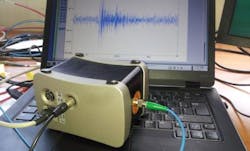SWIFTS optically integrated spectrometer measures earth tides and earthquakes near and far
A miniature, optically integrated spectrometer based on SWIFTS technology (stationary-wave integrated Fourier-transform spectrometer; see related links below for more info) has successfully measured extremely small deformations of the Earth's crust, on the order of one millimeter, over a length of one thousand kilometers.1 Researchers at the Institut des Sciences de la Terre (CNRS/Université Joseph Fourier/IRD/IFSTTAR/Université de Savoie; Chambéry, France) and the Institut de Planétologie et d'Astrophysique de Grenoble (CNRS/Université Joseph Fourier; Grenoble, France) used the spectrometer to detect these as yet poorly understood movements.
RELATED: Spectroscopy: High-resolution spectrometers shrink down with SWIFTS
RELATED: SPECTROMETERS: SWIFTS spectrometer technology miniaturizes and increases performance
RELATED: Resolution Spectra Systems high-resolution spectrometer covers the visible to NIR range
Earthquakes are not the only phenomena to deform the Earth's crust. But slower, more continuous deformations, such as those caused by Earth tides or by slow earthquakes, are sometimes difficult to detect using large-scale techniques like GPS or seismic sensors.
Resolution of one part per billion
The team carried out the measurements at the Low Noise Underground Laboratory (CNRS/Université de Nice/Université d'Avignon), located in a former nuclear-missile firing station on the Plateau d'Albion in southern France. The exceptional conditions at the site allow accurate research to be carried out, shielded from variations in pressure and temperature at a depth of 300 m underground. As a result, the system used was able to measure deformation, notably caused by Earth tides, at a resolution of one part per billion. This is equivalent to a variation of one millimeter over a length of one thousand kilometers. As well as measurements related to Earth tides, the instrument also measured a signal from the 2014 Iquique earthquake in Chile.
In the system, white light travels through a fiber and is reflected by two Fabry-Pérot interferometers, each formed by two Bragg gratings. The series of reflections only transmits certain wavelengths to SWIFTS. The spectrometer can then determine the relative position of the two mirrors to the nearest nanometer, thus making it possible to assess the extent of the deformation.
The SWIFTS spectrometer was developed by Resolution Spectra Systems, a start-up company stemming from research carried out at Joseph Fourier University in Grenoble. The extremely small size of the spectrometer, 30 x 1.5 x 1.5 mm, means that measurements can be taken using an instrument the size of a matchbox. This could eventually make it possible to set up a network of sensors in areas of tectonic activity or on volcanoes. Studies carried out on the 1999 Izmit earthquake in Turkey and the 2011 Tohoku-Oki earthquake in Japan revealed the existence of slow precursory displacements before the main quake. This is precisely the type of phenomenon that SWIFTS can measure, which could contribute to forecasting the onset of such natural disasters.
Source: http://www.alphagalileo.org/ViewItem.aspx?ItemId=152031&CultureCode=en
REFERENCE:
1. Olivier Coutant et al., Optica, 23 April 2015; http://dx.doi.org/10.1364/OPTICA.2.000400

John Wallace | Senior Technical Editor (1998-2022)
John Wallace was with Laser Focus World for nearly 25 years, retiring in late June 2022. He obtained a bachelor's degree in mechanical engineering and physics at Rutgers University and a master's in optical engineering at the University of Rochester. Before becoming an editor, John worked as an engineer at RCA, Exxon, Eastman Kodak, and GCA Corporation.
